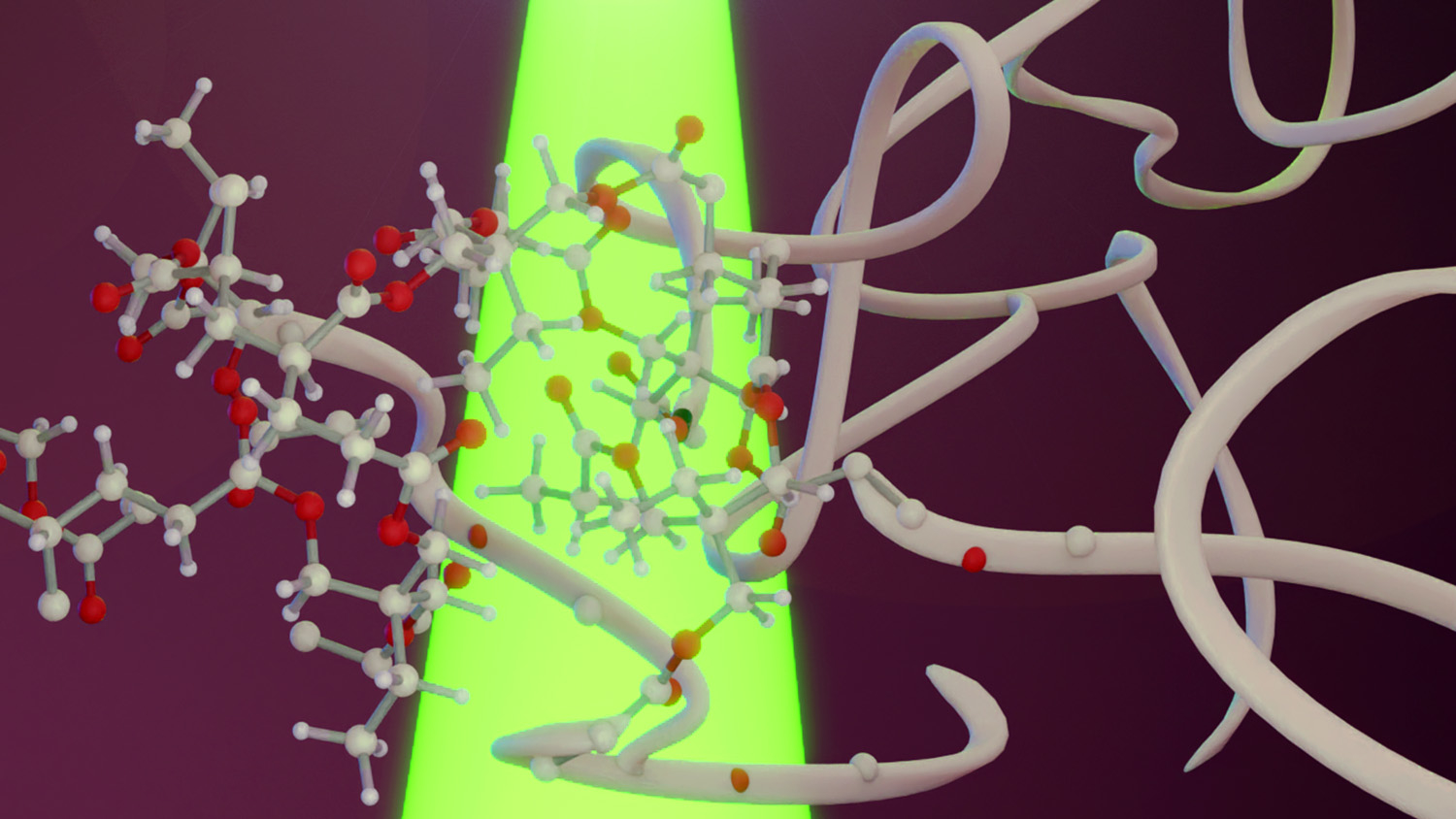Researchers Discover New Photoactivation Mechanism for Polymer Production

For Immediate Release
A team of researchers from North Carolina State University has demonstrated a way to use low-energy, visible light to produce polymer gel objects from pure monomer solutions. The work not only poses a potential solution to current challenges in producing these materials, it also sheds further light on the ways in which low energy photons can combine to produce high energy excited states.
Polymer products – primarily plastics – are used in everything from water bottles to medical applications, with billions of pounds of these materials being produced annually. Select polymers can be produced via a process called free radical polymerization, in which a monomer solution is exposed to ultraviolet (UV) light. The high energy of UV light enables the reaction, forming the polymer. The advantages of this method include fewer chemical waste byproducts and less environmental impact.
However, this method is not without drawbacks. The high energy UV light used in generating these polymers can also degrade plastics and is unsuitable for producing certain materials.
Felix N. Castellano, Goodnight Innovation Distinguished Chair of Chemistry at NC State, had previously shown that it was possible to combine lower energy molecules’ excited states to achieve more potent excited states. In a new contribution, Castellano and his team applied a process – called homomolecular triplet-triplet annihilation – to polymer production, by using lower energy yellow or green light to create polymer gels.
The team dissolved zinc(II) meso-tetraphenylporphyrin (ZnTPP) into two different pure monomers – trimethylolpropane triacrylate (TMPTA) and methyl acrylate (MA) – then exposed the solutions to yellow light. Energy from the light creates the homomolecular triplets in ZnTPP, and when those triplets combine, they create an extremely short-lived S2 excited state that has enough energy to power the polymerization process.
“While triplets are really long lived in chemical terms – they live for milliseconds – the S2 excited state only lives for picoseconds, which is nine orders of magnitude less,” Castellano says. “One of the important facets of this work is demonstrating that if you have a pure liquid you can utilize this potent, short-lived excited state to facilitate important transformations. The neat liquid ensures that electrons are transferred efficiently.”
The team conducted spectroscopic analysis of the solution, establishing the existence of the S2 excited state in the presence of yellow and green light. “We used ZnTPP because it allows you to see light emission from two different excited states and we could differentiate between lower energy S1 and higher energy S2 states,” Castellano says. “We know that polymer formation is a direct result of the S2 excited state, but we can also show that’s what happening spectroscopically.”
The work appears online in Chem, and was funded through BioLEC, an Energy Frontier Research Center supported by the U.S. Department of Energy (DE-SC0019370). Castellano is corresponding author. NC State graduate student Nancy Awwad is first author. Anh Thy Bui, a former NC State postdoc currently of the University of Rennes, France and NC State IMAKS Lab Director Evgeny O. Danilov also contributed to the work.
-peake-
Note to editors: An abstract follows.
“Visible-Light-Initiated Free-Radical Polymerization by Homomolecular Triplet-Triplet Annihilation”
DOI: 10.1016/j.chempr.2020.08.019
Authors: Nancy Awwad, Evgeny O. Danilov, Felix Castellano, North Carolina State University; Anh Thy Bui, Univ Rennes, Rennes, France
Published: Online Sept. 16 in Chem
Abstract:
Polymerization reactions initiated by ultraviolet light are ubiquitous in scores of industrial applications but would markedly benefit from visible-light activation to overcome stability, energy consumption, light penetration, and sample geometry limitations. The current work leverages visible-light-driven homomolecular triplet-triplet annihilation (TTA) in zinc(II) meso-tetraphenylporphyrin (ZnTPP) to initiate facile free-radical polymerization in trimethylolpropane triacrylate (TMPTA) and methyl acrylate (MA) monomers through ultrafast electron transfer quenching. Selective Q-band (S1) excitation of ZnTPP in the green or yellow sensitizes TTA occurring between two 3ZnTPP* energized chromophores, ultimately generating the highly reducing S2 excited state on one ZnTPP molecule (Ered = -2.13 V versus SCE). Subsequently, this S2 state engages in electron transfer with TMPTA or MA, thereby initiating the radical polymerization process. Bimolecular electron transfer was confirmed through optically gated fluorescence upconversion. FT-IR and EPR spin-trapping experiments verified visible-light-initiated polymerization leading to the formation of well-defined macro- and microscopic objects.
This post was originally published in NC State News.